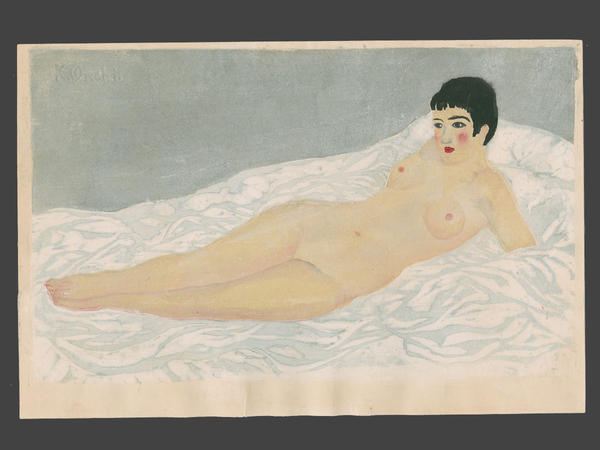| Notes (first edition)?: |
Artist Onchi (1891-1955)
Title Bare Skin on White Cloth
Date Of Work 1929
Publisher
Dimensions 10.375 x 15.75
Notes Perhaps Onchi's most influential print. Extremely rare. Fine Mica Ground.
From COLLECTING JAPANESE PRINTS:
Koshiro Onchi was one of the leading printmakers in 20th century Japan. He is credited with producing the first work of abstraction in printed form in 1915. Onchi’s prints are stylistically varied and he was comfortable working in both abstraction and representational formats. He is known for imbuing his work with an expressive quality that was thought provoking and emotionally potent. In many cases, his most expressive work remains unrivaled today. With his charisma, Onchi tended to the flame of the Sosaku Hanga movement during the dark years leading to and during the war by encouraging artists to produce creative prints for art’s sake.
This design features a reclining nude, in the tradition of Manet's Olympia. Like Manet, Onchi's nude is unapologetic of her state. In fact, Onchi's nude goes even further, as this unique variant is depicted with pubic hair--not a conventional representation for nudes at this time. There is some bit of irony that an artist with deep roots in abstraction would choose to produce a print with such unapologetic realism. This impression is also noteworthy for the amount of attention Onchi has given both the white cloth and the nude's skin. The white cloth appears to have volume and a velvet-like texture while the woman's skin is a lifelike yellow white, further accentuating the realism of the work.
Connoisseur's Note
It is interesting to note that every single impression of this design appears different. Onchi did not believe in producing unified printed work; he saw printmaking as a creative process, not a mode of duplication, with each printing as an opportunity to express his emotional state at the moment. This particular unique variant impression is important due to its keen sense of realism which was shocking and emotionally triggering at the time of production. |
|





